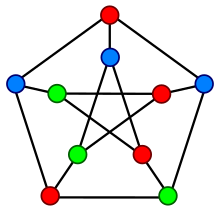chromatic number
English

Noun
chromatic number (plural chromatic numbers)
- (graph theory) The smallest number of colours needed to colour a given graph (i.e., to assign a colour to each vertex such that no two vertices connected by an edge have the same colour).
- 1995, J. A. Bondy, 1: Basic Graph Theory: Paths and Circuits, Ronald L. Graham, Martin Grötschel, László Lovász (editors), Handbook of Combinatorics, Volume 1, Elsevier (North-Holland), page 48,
- The chromatic number of a graph is the minimum value of for which is -colourable, and is denoted by . […] A more essential use of the chromatic number was made by Gallai (1968a) and Roy (1967), who discovered a simple relationship between the chromatic number of a digraph and the length of a longest directed path in the digraph, where the chromatic number of a digraph is defined to be the chromatic number of its underlying graph .
- 2004, Monia Discepoli, Ivan Gerace, Riccardo Mariani, Andrea Remigi, A Spectral Technique to Solve the Chromatic Number Problem in Circulant Graphs, Antonio Laganà, et al. (editors), Computational Science and Its Applications, ICCSA 2004: International Conference, Proceedings, Part 3, Springer, LNCS 3045, page 745,
- The CHROMATIC NUMBER is the minimum number of colors by means of which it is possible to color a graph in such a way that each vertex has a different color with respect to the adjacent vertices. Such a problem is an NP-hard problem [14] and [it] is even hard to obtain a good approximation of the solution in a polynomial time [17]. Although in a lot of computational problems the cost decreases when these problems are restricted to circulant graphs [6, 9], the CHROMATIC NUMBER problem is NP-hard even restrecting[sic] to circulant graphs [9]. Moreover the problem of finding a good approximation of the CHROMATIC NUMBER problem on circulant graphs is also NP-hard.
- 2009, Gary Chartrand, Ping Zhang, Chromatic Graph Theory, Taylor & Francis Group (CRC Press / Chapman & Hall), page 149,
- There is no general formula for the chromatic number of a graph. Consequently, we will often be concerned and must be content with (1) determining the chromatic number of some classes of interest and (2) determining upper and/or lower bounds for the chromatic number of a graph.
Usage notes
- Not to be confused with chromatic index (aka edge-chromatic number), which is the equivalent minimum number for an edge colouring.
- The chromatic number of a graph is often denoted .
Synonyms
- (smallest number of colours needed to colour the vertices of a graph): vertex chromatic number (used to differentiate from edge chromatic number, etc.)
Derived terms
Related terms
Translations
smallest number of colours needed to colour a graph
|
See also
Further reading
 Graph coloring on Wikipedia.Wikipedia
Graph coloring on Wikipedia.Wikipedia  Edge coloring on Wikipedia.Wikipedia
Edge coloring on Wikipedia.Wikipedia  Total coloring on Wikipedia.Wikipedia
Total coloring on Wikipedia.Wikipedia  Hadwiger conjecture (graph theory) on Wikipedia.Wikipedia
Hadwiger conjecture (graph theory) on Wikipedia.Wikipedia








